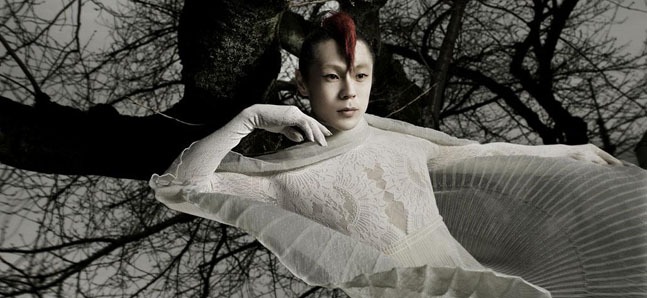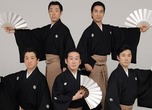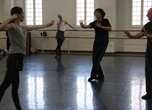‘To dance is to live’
The wondrous world of Kaiji Moriyama the New York Times called ‘amazing’

Posted: Tue Jul 20 2010
Kaiji Moriyama says that dancing is living – he is 36 years old. Surprisingly, he only took up dance at the age of 21. Although it’s much more common to take up contemporary dance at a later age than a form like classical ballet, it still is considered in the dance world a bit old to be starting. Now compound that with the fact that Moriyama has said that as a child he was never good at expressing himself through performance in front of others.
Despite the late foray, in the few short years since he discovered dance he has achieved impressive results. At the 2001 Edinburgh Festival he was praised as ‘one of the most talented dancers of the year’, and in 2005 the New York Times said of his performance ‘Katana’ that it was ‘a dance of amazing concentration by an amazing dancer’. Tickets sell out for every solo performance he stages, and along with his popularity, skill and critical acclaim, he has become one of the top dancers on the world stage.
On June 26 Moriyama performed in a production of William Butler Yeats’s ‘At the Hawk’s Well’, a play that was heavily influenced by Yeats’s contact with Japanese Noh theatre. Co-performers included Yuan Yuan Tan (who was named one of Time Asia’s top 20 ‘Asian Heroes’ in 2004 and has held the position of principal dancer with the San Francisco Ballet for the past 15 years), and Noh actor Gensho Umewaka. In July, to mark the 10th anniversary of his first solo performance in 2001, Moriyama will once again perform an interpretation of the Japanese folktale ‘Tsuru no Ongaeshi’ in his show ‘Tsubasa’. The production also involves the work of many of today’s budding artists, from fashion designers to jazz musicians. To follow up, in August Moriyama is set to perform in a Takigi Noh play on Sado Island.
Moriyama uses dance to create his own unique form of expression, which moves freely between the new and the old, and cannot be imitated by anyone else. Time Out Tokyo spoke to him about where the source for his distinctive style can be found.
‘When I was 21, I went to a musical for the first time and I thought “This is it!” Up until then I never knew what form I could use to articulate what I wanted to express, and I was actually the type who keeps everything bottled up inside. From that time I joined a theatrical company and started to learn all of the dance skills that you need for musicals – like ballet and jazz dance – all at the same time. I started to question all the different styles of physical expression in the various genres of dance, like, “Why does ballet have this kind of movement?” Finding which ones didn’t suit the way my body wanted to move became really interesting. I discovered that it was dance, rather than musicals with which I wanted to express myself. The feeling, “This is the way I want to do it,” started to come to me and I thought if I didn’t create the dance myself I couldn’t convey that feeling, so I started doing creative dance.’
When one hears a dancer speaking, there is a tendency to focus on what discipline they followed when they were still training, which competition they received critical acclaim at and which company they belong to. The fact remains that, however, you don’t need a license for a dance that will move those who see it. Just like there are freelancers in any field, there are expressions that can only be articulated by Moriyama, who freed himself from traditional dance methods.
‘Because I started at the age of 21, from the outset it wasn’t an option to study abroad or enter competitions. Maybe I should have studied all the basics from the beginning, but the reality was that I didn’t have the time. After I’d decided to make my way in the world of dance I had to think how I could make a place for my own expression in it. A process of trial and error led me to the conclusion that maybe I was taking a path in dance that no one else was. Actually, the fact that I didn’t study dance from a young age has had a part in why I am doing what I do now. When I was little I was really embarrassed to appear in front of other people, and I had a fear of blushing. But, because of that I felt a much stronger need than others to express myself. Perhaps my late discovery of dance is why those kinds of feelings continue to burst out of me.’
This young man, who found it difficult to express his feelings, let alone move his body expressively to music, discovered dance. He has said of that moment, ‘I was so happy, I threw myself completely into it without any hesitation.’ Moriyama presents his audience with a newer style of dance than any of his peers, but he also has a deep connection with Japanese traditions. He produced his work ‘Tsubasa’ – which is based around a folk tale any Japanese person is bound to know – and he frequently collaborates with the traditional arts like Noh theatre. So how does he feel about the concepts of ‘Japan’ and ‘tradition’? For Moriyama, the keyword is ‘absence’.
‘Since I was young, I’ve always been the type to hide in other people’s shadows, so I’m good at erasing any signs of my presence. Rather than a dance that says “I’m here,” I’m interested in one that expresses the notion “I’m not here.” I think that is related to why I became attracted to classical Japanese literature and Noh theatre. In many Noh plays the protagonist is a ghost. They are works where someone who shouldn’t be there ‘appears’. It’s a type of existence that is uniquely Japanese. Yeats was drawn to those Japanese sensibilities too when he wrote ‘At the Hawk’s Well’. It’s like a story of people who are able to make things that didn’t originally exist manifest themselves. Amongst all the fluctuations in the ‘culture’ that makes up Japan now, it’s become hard to see what ‘Japan’ really is. But I believe that the traditions that have been cultivated to make Japan are still alive, so I want to bring tradition and what is new into contact. What I can do myself is have a part in creating the culture of the Japan that exists now. So I have to really look at what is ‘now’ and I want to create things which have a proper grounding in all of the traditions which we have inherited from the past.’
If Kaiji Moriyama had been born in the Muromachi Period, perhaps he would have been one of those who helped create the then new performing art ‘Noh theatre’. He makes us feel that perhaps those who created ‘culture’ were people like him. Moriyama uses a broader perspective to create a kind of dance that plays a part in culture itself and he is active in a continually expanding range of fields, including teaching dance workshops for those involved in early childhood learning.
‘When people think about contemporary dance they tend to assume the position that it’s complex, that it expresses something intellectual, or something about the universe. But in my case, I think it goes back to the idea of wanting to impress people while dancing. For animals it’s a very fundamental thing. When animals like peacocks are trying to woo a mate, they dance. So, putting it another way, wanting to look good is part of the feelings of courtship – it’s an element of the initial stages of love. For me now, the word dance has become synonymous with the word body. So it’s not just dancers who are dancing. Everyone has a body, so everyone is dancing. Perhaps the real appeal of dance is in living over many long years. My mother died recently and she had an illness that made it difficult to move. Even making a single cup of tea was heartbreakingly difficult, but she would try her hardest to express herself and to show hospitality. That was dance. Japanese people have an inherent love of dance. In the past it was an everyday thing to have a place, like a festival, to dance. But these days, as a location where people can gather and see a performance, the stage has taken on that role. I’m going to fling my body around the stage and dance, so I’d love it if you could bring yourself to the theatre to see me.’
Kaiji Moriyama has lived not knowing how to express himself, but embracing a deep hunger to do so. Trying desperately to find a dance that was his own, he has now come to face what it is to dance on a new horizon. When you watch his style of dancing – which questions life itself – perhaps a desire to dance that has been sleeping inside of you will be awakened.
Kaiji Moriyana Solo Dance Tour ‘Tsubasa’
Choreography, Art direction, Performance: Kaiji Moriyama
Date: Fri July 23-Sun July 25
Time: July 23 7.30pm; July 24 2pm, 7pm; July 25 2pm
Location: Setagaya Public Theatre (Full details & map)
Tickets: S ¥6,000, A ¥4,500; S ¥5,500 adv, A ¥4,000 adv
Ticket inquiries: (03)5432 1515
Online ticket sales: setagaya-pt.jp/en/ticket_buy/
Ticket Pia: (0570) 02 9999
Sado Takigi Noh (Bonfire Noh Performance)
Date: Wed Aug 18, Thur Aug 19
Inquiries: Sado Tourism Association (0259)27 5000
Website: www.kodo.or.jp/ec/event/relation2_en.html
Kaiji Moriyama Dance Exhibition (image works)
Date: Thur Nov 11-Wed Dec 22
Location: Gallery A4 (located inside Tokyo Main Office Building of Takenaka Corporation)
Website: www.kaijimoriyama.com/
Tweets
- About Us |
- Work for Time Out |
- Send us info |
- Advertising |
- Mobile edition |
- Terms & Conditions |
- Privacy policy |
- Contact Us
Copyright © 2014 Time Out Tokyo














Add your comment